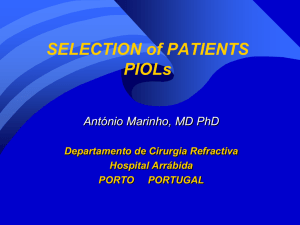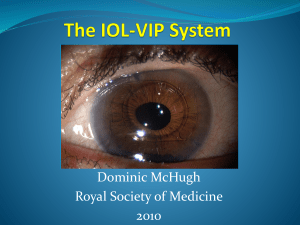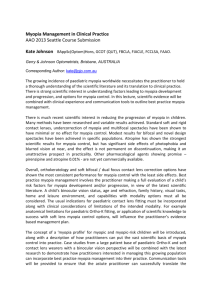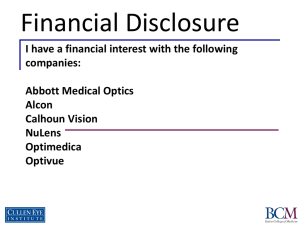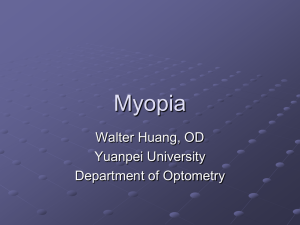PHAKIC
advertisement
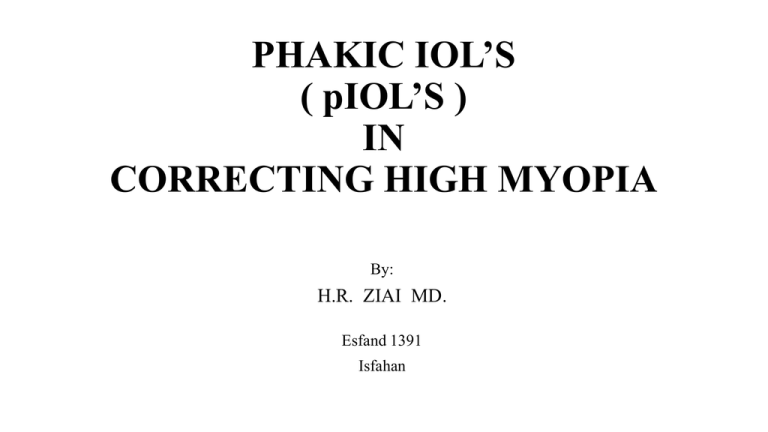
PHAKIC IOL’S ( pIOL’S ) IN CORRECTING HIGH MYOPIA By: H.R. ZIAI MD. Esfand 1391 Isfahan HISTORY • 1950s : First ideas formed • 1988 : Angle supported PMMA, ZB5M & MA20, by Bikoff • But : • Discontinued because of complications ( corneal edema, iritis ,… ) HISTORY • 1988 : First phakic iris – clawed IOL • introduced for myopia by Worst • 1998 : Artisan – Worst by OPHTEC • Then changed it’s name to Artisan – Verysise • and it’s flexible form to Artiflex HISTORY • 1987: First PC pIOL or sulcus support pIOLs introduced : •- Phakic Refractive Lens ( PRL ) by CIBA VISON . • And then : •- Implantable Contact Lens ( ICL ) • or Implantable Collamer Lens ( ICL ) •- Collamer is a copolymer of • hema ( 99% ) and porcine collagen ( 1% ) CLASSIFICATION OF pIOLS • • • Ant.Chamber pIOLS ( AC pIOLS) - Angle supported 1) PMMA 2) Foldable Clawed • • • • - Iris – 1)PMMA 1)Foldable Post.Chamber pIOLS ( PC pIOLS ) (or sulcus supported ) \\\ INDICATIONS • High Myopia • - Myopia > -8.00 to -10.00 D • - Stromal bed < 300µ after laser ablation • - Keratometry < 34-36D after laser ablation • • FDA Approval for Artisan/Artiflex •- Myopia : -5.00 to -20.00 D •- Ast. < 2.5 D •- Age > 21 y •- ACD > 3.2 mm • FDA Approval for ICL : •- Myopia : -3.00 to -20.00 D •- Ast.< 2.50 D •- Age 21 - 45 y •- ACD > 3.00 mm • High Hyperopia • - Keratometry > 50 D after laser ablation • - Available pIOLS : • • • ICL : Up to +20.0 D Artisan : Up to +12.00 High Ast. • - Laser ablation is the Tx of choice for Ast. up to 4.00 – 5.00 . • - PIOLS are available too . CONTRAINDICATIONS • - Any intraocular pathology • ( Cat. , Glaucoma , NVI , Uveitis , … ) •- ↓ ACD • - ↓ Diameter ADVANTAGS OF pIOLS • - Rang of correction >> Laser • - Easy technique ( Like Cat. Surgery ) • - Less expensive instruments than Laser • - Removable • - No ↓ in contrast sensitivity • even : ↑ Compared with spectacle • -More predictable DISADVANTAGES OF pIOLS •- All intraocular risks •- Large incision ( in PMMA types ) •- Limitation in hyperopia due to small ant. segment •- Irreversible complication PRE-OP EVALUATION •- Power of IOL •- Diameter of IOL for angle or sulcus supported IOLs •- ACD •- Specular microscopy •- Optic size in correlation to scotoptic pupil size •- All other rutin evaluation before cat. surgery Cont. • But : • Main challenge in angle or sulcus supported pIOLs is : • “ Sizing IOL diameter” • Through Angle-to-angle • And ciliary sulcus diameter Cont. • For angle supported pIOLS •- 0.5 – 1.00 mm add to w-to-w measured manually or by orbscan, although not always correct . •- Use of OCT/UBM Cont. • Note: •If diameter measured horizontally the lens must implanted horizontally; if implanted vertically, it causes Decenteration , Ovalization , Iritis , Glaucoma. Cont. • For PC pIOLS ( sulcus supported ) •- Add 0.50 – 1.00 mm to horizontal W-W •- New ultrasound techniques like Artemis & UBM ANGLE SUPPORTED pIOLS • Surgical Technique (important points) • -Incision , 2- 6.5mm (based on type ) •- Sup. approach ( more common ) •- Retrobulbar avoided ( glob perforation ) •- IOL dialled to the best pupil-optic matching Cont. •- Surgical PI •- OVD irrigated meticulously •- Pilo 2 ( useful , but may decentered pupil Complications •- Haloes and Glare : more com complication ( 20 % ) • more in 1th year, but : ↓ over time •- Pupil ovalisation ( 7-22% ) ( if oversized ) •- Iris retraction and atrophy Cont. •Endothelial cell damage: •-Surgical trauma - Presence of IOL - 5- 7% in 1th year and less in next years Too small size : ↑ damage Cont. •- ↑ IOP • - Transient , 2’ to OVD • - Topical CS • - Pupilary block •- Uveitis : 4.5% • - Usually transient , 2’ to iris manipulation • - In over sized IOL , may chronic, causing glaucoma cat. , PAS, Iris damage , … Cont. •- Cataract • - Less common than PC pIOL • - Caused by trauma , uveitis • - Age > 40 y at time of surgery • - AL > 30 mm •- RD : 3% • If pIOL have additive risk for RD over the myopia?? Cont. •Rare complications • - Corneal decompensation • - Urretis – Zavalia synd. • - Malignant glaucoma • - Endophthalmitis • - Hyphema IRIS FIXATED pIOLs • General information of Artisan • - 0.5 mm vault ( 0.8 mm distance between IOL & crystalin lens) • - Diameter : 8.5 mm • - Optic : 6.5 & 6.0 mm • - Center :0.2 mm thickness Indications ( FDA ) : •- Myopia •- Hyperopia •- RE After PK •- Sever anisometropia in children •- Aphakia •- KCN •- Progressive high myopia in psudophakic children Complications •- Glare & haloes: 0-9% more in small optics ( 5mm ) and Large pupil ( > 5.5 mm ) •- AC inflammation: 0.5% •- Pigment dispersion : 2” to poor enclavation • -Crystalin lens rise: like Hyeperopia ( Artiflex > Artisan ) because of step in haptic junction optic- Cont. •Endothelial cell loss • - Intraoperative trauma ( main cause ) • - more in first 6m post op. • - ACD < 3.2 → ↑ risk •Glaucoma • - Usually transient • - OVD , CS , pigment , inflammation Cont. •Cataract : 3% - NS •- Age > 40 at implantation time →↑risk •- AL > 30 mm →↑ risk • Other complications • • • - Hyphema - Intermittent myopic shift - RD PC PIOLs ( SULCUS SUPPORTED ) •- PRL : Silicon , hydrophobe •- ICL : Hydrophyl , biocompatible , permeable Complications •-Glare & halos • 8.4 % , ↓ over time • -Flare ; 27%, Up to 2y •-Cataract • - The major concern • - 0.6 – 3 % • - Traumatic contact , metabolic disturbance • - Ant. sub capsular Cont. •Pigment dispersion & deposition • - Iris rubbing • - ↑ Size ( ↑ Vault ) →↑ dispersion •Glaucoma • - 2’ to pigment dispersion • - Angle closure • - Pupilary block ( if fibrin formed ) • - ICL > PRL •Decenteration : The most complication • - Small size IOL, difficult problem • - Even sometime dislocation into vitreous cavity • Note : • In PC pIOL, vault is of critical importance •- ↑ Vault → ↑ Pigment dispersion •- ↓ Vault → ↑ Cataract BIOPTICS •Implantation of pIOL followed by Laser ablation •- In case of extremely myopia , high Ast. , lens power not available. •- Safe and effective FEW SELECTED POINTS •- PIOLs have been used successfully for post PK Ast. •- Artisan induces HOA less than APT because of reserving prolate shape of cornea. •- Toric pIOL + CXL successfully have been used for correcting RE in mild to moderate KCN & PMD. Cont. • - AC pIOLs have been used for TX of children with sever myopic anysometropia ( > -8.00 ) that resist or no cooperative for traditional amblyop therapy with encouraging results . CONCLUSION • Compared with corneal laser ablation, pIOLs are excellent in : • - Predictability • - Efficacy • - Safety • - Quality of vision ضمن عرض پوزش بدلیل حجم باالی LECTUERادامه اسالیدها امکان پذیر نمیباشد در صورت نیاز به ادامه لطفا به واحد سمعی و بصری مرکز آموزشی درمانی فیض مراجعه و یا با شماره تلفن 03114476010داخلی 392تماس حاصل نمائید با تشکر
